NOW AVAILABLE!
Number 156 (Fall 2021)
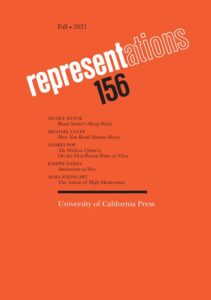
NICOLE DUFOE
MICHAEL LUCEY
ANDREI POP
The World as I found it: On the First-Person Point of View
JOSEPH DARDA
ALMA STEINGART


NICOLE DUFOE
MICHAEL LUCEY
ANDREI POP
The World as I found it: On the First-Person Point of View
JOSEPH DARDA
ALMA STEINGART
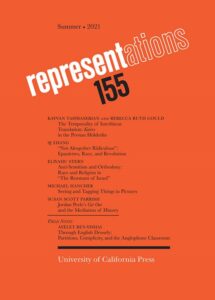
KAYVAN TAHMASEBIAN and REBECCA RUTH GOULD
The Temporality of Interlinear Translation: Kairos in the Persian Hölderlin
SJ ZHANG
“Not Altogether Ridiculous”: Epaulettes, Race, and Revolution
ELIYAHU STERN
Anti-Semitism and Orthodoxy: Race and Religion in “The Remnant of Israel”
MICHAEL HANCHER
Seeing and Tagging Things in Pictures
SUSAN SCOTT PARRISH
Jordan Peele’s Get Out and the Mediation of History
——————————–
FIELD NOTES
Ayelet Ben-Yishai
Through English Densely: Partitions, Complicity, and the Anglophone Classroom
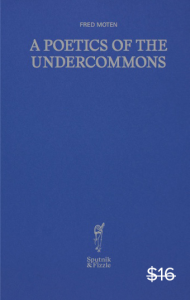 In this essay Martha Feldman proposes that current-day notions of fugitivity, understood in the terms Fred Moten delineates as a category of the irregular that escapes easy representations and predications, can undiscipline music histories in productive ways. Among these: it can inflect musicological thinking through attention to sonic remainders of haunted pasts; it can decenter understandings of the aesthetic; and it can lead to more nuanced thinking about the imbrication of music in an “undercommons” of life that refuses ever to fully sound in harmony, residing instead in a disordered space of restless, noisy sound. Feldman asks, finally, how such thinking, developed by Moten, Nathaniel Mackey, and Daphne Brooks, among others, can remake aspects of musicological thinking about voice.
In this essay Martha Feldman proposes that current-day notions of fugitivity, understood in the terms Fred Moten delineates as a category of the irregular that escapes easy representations and predications, can undiscipline music histories in productive ways. Among these: it can inflect musicological thinking through attention to sonic remainders of haunted pasts; it can decenter understandings of the aesthetic; and it can lead to more nuanced thinking about the imbrication of music in an “undercommons” of life that refuses ever to fully sound in harmony, residing instead in a disordered space of restless, noisy sound. Feldman asks, finally, how such thinking, developed by Moten, Nathaniel Mackey, and Daphne Brooks, among others, can remake aspects of musicological thinking about voice.
The essay begins:
A vibrant strain of avant-garde writing is nowadays centering music as the medium of a luminously varied Black radical aesthetic without much of musicology yet noticing. Such work might bring to mind sonic points along a dolorous history, from “the deep meaning of those rude and apparently incoherent songs” of slaves traveling to receive their monthly food allowance that Frederick Douglass heard on the plantation—what W. E. B. Du Bois called “sorrow songs,” “through which the slave spoke to the world”—to the stirring blues laments of Ma Rainey, Bessie Smith, Billie Holiday, and Nina Simone brought to light by modern-day Black feminists. Today’s Back avant-garde stretches out from such moments, addressing long histories of racial subjugation and violence intimately bound up with modern histories of capitalism, but it’s up to something different. It understands its aesthetic objects through a nexus of politics, philosophy, and metaphysics that often goes by the name of fugitivity, a concept that encompasses those earlier soundings while resituating them. Not restricted to literal flight from slavery, fugitivity belongs to what philosopher and poet Fred Moten—thus far its most expansive and challenging theorist—describes as a capacious category of the irregular in which freedom and unfreedom perpetually coexist in persons who refuse to be objectified or reduced. Only when a Black being recognizes their oppression, victimization, or commodification by speaking, talking back, or refusing to be named and delimited does fugitivity become a lived reality. Only then does it move in its characteristic temporal arc, bending toward the future even while haunted by a past that is never past. Moten conveys this existential condition in a disarming passage about the resonance between the slave narrative passed down to posterity by Harriet Jacobs (1861) and a nude photograph of an anonymous prepubescent Black girl captured in 1882 in the studio of Philadelphia artist Thomas Eakins:
The moment in which you enter into the knowledge of slavery, of yourself as a slave, is the moment you begin to think about freedom, the moment in which you know or begin to know or to produce knowledge of freedom, the moment at which you become a fugitive, the moment at which you begin to escape in ways that trouble the structures of subjection that—as Hartman shows with such severe clarity—overdetermine freedom. This is the musical moment of the photograph.
Provocatively, fugitivity here, regardless of its expressive medium, has a consistency that is decidedly musical.
I want to pause at this juncture—obscure at its surface, for how can a photograph without an iota of literal sound have a “musical moment”?—because the notion is pivotal, turning on what Moten elsewhere calls “visible sound.” Avid readers of Moten will recall another photograph that clamors at various points in his prose, that of the desecrated body of young Emmett Till, whose mother insisted he be displayed in all the horror of his savage murder. The image contains what Moten calls an “extensional cry and sound,” one whose power to overtake the viewer’s senses ignites the memory with a disturbance that transduces other senses, other embodied memories.
An image from which one turns is immediately caught in the production of its memorialized, re-membered reproduction. You lean into it but you can’t; the aesthetic and philosophical arrangements of the photograph . . . anticipate a looking that cannot be sustained as unalloyed looking but must be accompanied by listening and this, even though what is listened to—echo of a whistle or a phrase, moaning, mourning, desperate testimony and flight—is also unbearable. These are the complex musics of the photograph. This is the sound before the photograph.
The music sounds before the camera clicks, before the viewer views, and sounds again once the viewer looks. Music both precedes and expresses Black life. It triggers memories that turn into griefs and horrors, more images, and (as we learn elsewhere) bundles of sensory events beyond the strictly auditory or visual. Not just unidirectional, however, medial/sensory transformations and intermediations also go the other way. Hence Jacobs, at a devastating moment in her account, hears “a band of serenaders . . . under the window, playing ‘Home Sweet Home,’” which soon turns into the sounding image of moaning children.
 Music here is no more resident solely in physical sound than in sounding music. Wherever found, Black music registers fugitive escape via the phonic eruption, which equates to Black experience and is prefigured by the scream or cry whose originary American instance (to which Moten turns twice, following Saidiya Hartman) are the screams of Frederick Douglass’s Aunt Hester being viciously beaten by her owner. Contained “in the break” (the main title of Moten’s first book), the cry disrupts conventional grammars, strictures, and forms, indexing a breakdown or breakage, but also, relatedly, a breakthrough—a Black event that moves the subject from bondage, conscription, and silence to flight, marronage, and voice. Such flight takes the form of a literal (and for Moten paradigmatic) scream in Abbey Lincoln’s performance of Max Roach and Oscar Brown Jr.’s Freedom Now Suite (1960), a piece that is otherwise “musical” in the ordinary sense. But fugitive flight also takes other sonic forms: a plangent, wailing jazz solo; the explosive shouts in James Brown’s “Cold Sweat”; the lyrical, dancing rhythms of Rakim’s hip-hop, for example—all instances of Moten’s philosophies repeatedly articulating the Black radical aesthetic that Michael Gallope describes “as folds, blurs, oscillations, and rewinds; as displacement and dispossession; as the entanglement of lyricism, performativity, improvisation, and virtuosity.” Continue reading …
Music here is no more resident solely in physical sound than in sounding music. Wherever found, Black music registers fugitive escape via the phonic eruption, which equates to Black experience and is prefigured by the scream or cry whose originary American instance (to which Moten turns twice, following Saidiya Hartman) are the screams of Frederick Douglass’s Aunt Hester being viciously beaten by her owner. Contained “in the break” (the main title of Moten’s first book), the cry disrupts conventional grammars, strictures, and forms, indexing a breakdown or breakage, but also, relatedly, a breakthrough—a Black event that moves the subject from bondage, conscription, and silence to flight, marronage, and voice. Such flight takes the form of a literal (and for Moten paradigmatic) scream in Abbey Lincoln’s performance of Max Roach and Oscar Brown Jr.’s Freedom Now Suite (1960), a piece that is otherwise “musical” in the ordinary sense. But fugitive flight also takes other sonic forms: a plangent, wailing jazz solo; the explosive shouts in James Brown’s “Cold Sweat”; the lyrical, dancing rhythms of Rakim’s hip-hop, for example—all instances of Moten’s philosophies repeatedly articulating the Black radical aesthetic that Michael Gallope describes “as folds, blurs, oscillations, and rewinds; as displacement and dispossession; as the entanglement of lyricism, performativity, improvisation, and virtuosity.” Continue reading …
 MARTHA FELDMAN is the Edwin A. and Betty L. Bergman Distinguished Service Professor of Music at the University of Chicago. Her books include Opera and Sovereignty (Chicago, 2007), The Castrato (Oakland, 2015), and the coedited The Voice as Something More: Essays toward Materiality (Chicago, 2019). She is now working on a book on castrato phantoms in twentieth-century Rome.
MARTHA FELDMAN is the Edwin A. and Betty L. Bergman Distinguished Service Professor of Music at the University of Chicago. Her books include Opera and Sovereignty (Chicago, 2007), The Castrato (Oakland, 2015), and the coedited The Voice as Something More: Essays toward Materiality (Chicago, 2019). She is now working on a book on castrato phantoms in twentieth-century Rome.
 Representations board member Ian Duncan will give the 2021 Wolfgang Iser lecture on June 30, 2021 (9:00am PDT). The talk, entitled “The Fiction-Making Animal: Revisiting Literary Anthropology,” will be streamed over Zoom here.
Representations board member Ian Duncan will give the 2021 Wolfgang Iser lecture on June 30, 2021 (9:00am PDT). The talk, entitled “The Fiction-Making Animal: Revisiting Literary Anthropology,” will be streamed over Zoom here.
Professor Duncan is the author of “Natural Histories of Form: Charles Darwin’s Aesthetic Science” (Representations 151, 2020) and “George Eliot’s Science Fiction” (Representations 125, 2014). His most recent book, Human Forms: The Novel in the Age of Evolution, came out in 2019.

Feldman and Mathew, guest editors of our just-released special issue “Music and Sound at the Edges of History” introduce the issue:
Lately, across the humanities, historicism in its many guises has been in retreat—a retreat that music studies has in some respects hastened. This collection of essays asks why sound and music appear to induce exhaustion with history and historical method and how a renewed focus on musical practices might motivate fresh histories and novel forms of history writing.
Such questions were the premise of a multidisciplinary Mellon-funded collaboration between Yale University, the University of California at Berkeley, the University of Chicago, and King’s College London that met from 2016 to 2018. Charged with rethinking the relation of music to history, the participants ultimately wondered why scholars, musicological and non-, have so frequently deployed music to disrupt or delimit historical projects—indeed whether music itself tends to elicit or even cause such disruptions and delimitations. The ironies here are patent. Not long ago, musicologists would regularly posit history as the most efficacious cure for what ailed their discipline. The study of music, so it was thought, always risked having its head in the clouds, especially the vapors of German idealism. To write music history was to place music’s feet on secure ground—to resituate, rematerialize, and re-embody in ways that checked the transcendental and formalist tendencies of old. “History,” by this reckoning, also designated a place, one where values are produced, where things are exchanged, where bodies move, where politics is played out. And yet, as many have observed, music has never been an entirely convincing occupant of this place, whose solidity is specious at best. Vibrational, ephemeral, footloose, politically mobile, and semiotically uncertain, music forever raises the specter of old philosophical anxieties—about the relation of the aesthetic to the historical, of sensuous experience to rational knowledge, of political orthodoxies to the undercommons of insurgency and resistance, of the vivid present to the absent past.[ii] Small wonder that so many theories of music’s historicity have treated musics of all kinds as strange and exceptional historical actors, even improbable bearers of special historical insight. “Janis Joplin, Bob Dylan, and Jimi Hendrix say more about the liberatory dream of the 1960s than any theory of crisis,” Jacques Attali once proclaimed.
Given this inheritance, it is not surprising that music studies has been receptive to the postcritical—and to a degree posthistoricist—ethos that has settled on parts of the humanities over the past decade or so. That ethos has entailed a range of aestheticizing impulses, in which immediate sensuous appeal or formal organization are the preconditions of any theory of art’s historical agency or political impact. Even the performative, network-oriented theories of society inspired by Bruno Latour, which some music scholars have strongly endorsed, have to some degree recuperated the art object as a multivalent social actor alongside any number of others. But if such ideas have gained a certain traction in music studies, a still farther-reaching incredulity with history-as-usual has come from those seeking to contest the political ontologies and colonial ideologies of the archive: Paul Gilroy in his account of Black Atlantic diaspora; Fred Moten in his theory of the Black radical tradition; the feminist and queer visions of Latinx and Black futures advanced by the music- and sound-oriented generations of Deborah Vargas, Josh Kun, Kara Keeling, and others, not to mention cognate projects in postcolonial and indigenous studies. These perspectives have challenged conventional notions of history and origins, drawing on the presence and performativity of music to model the disruptively enfolded temporalities and oblique regimes of historicity they wish to theorize. “No originary configuration of attributes but an ongoing shiftiness, a living labor of engendering to be organized in its relation to politico-aesthesis. It’s always going on and has been,” says Moten.
If, under the pressure of these political imperatives, the past has become ever less stable, so too has the music that helped to reconceive it. Sound studies and voice studies, cutting across and through disciplinary boundaries, have in recent years made the very category of music appear both narrow as an object of study and indefensibly colonial—a contingent configuration amid the seemingly more inclusive arenas of sonic practices, vocal utterances, and vibrational experiences. From this perspective, “music” and “voice” designate privileged centers by contrast with lesser peripheries and, accordingly, raise fraught questions about who gets to call what “music” and who and what are demoted to the realm of sound or dismissed as mere noise(making). These subdisciplines frequently seek to disperse sounds into the resonating bodies that have historically produced and mediated them and so seem to promise more materially grounded visions of sonic historicity. Yet they also tend to complicate the very idea of historical situatedness, foregrounding processes of mediation that fold and traverse geographical and chronological distance. Moreover, as music is diffused into the soundscapes, technoscapes, and taskscapes that have newly preoccupied the humanities and social sciences, it begins to trace a transhuman domain that threatens to transcend the ambit of human historicity altogether.
And so the essays in this issue aim to be more than mere experiments in music-fixated forms of historical writing—more, that is, than sonically recalibrated accounts of historical circumstance or epochal transformation in which music (rather than literature or visual art or architecture) plays an unusually prominent role. While remaining chary of inherited claims on behalf of music’s specialness as a vehicle of historical revelation, they ask how musical practices might be thought to instigate and sustain entirely new conceptions of the past and even how musico-critical practices might invoke ontologically broadened notions of music to revise historical thought. Continue reading …
MARTHA FELDMAN is the Edwin A. and Betty L. Bergman Distinguished Service Professor of Music at the University of Chicago. Her books include Opera and Sovereignty (Chicago, 2007), The Castrato (Oakland, 2015), and the coedited The Voice as Something More: Essays toward Materiality (Chicago, 2019). She is now working on a book on castrato phantoms in twentieth-century Rome.
NICHOLAS MATHEW is Professor of Music at the University of California, Berkeley. He is the author of Political Beethoven (Cambridge, 2013) and The Haydn Economy, forthcoming with the University of Chicago Press.
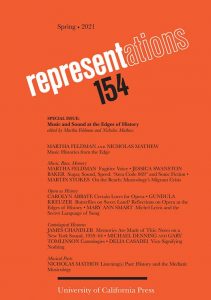 “Lately, across the humanities, historicism in its many guises has been in retreat—a retreat that music studies has in some respects hastened. This collection of essays asks why sound and music appear to induce exhaustion with history and historical method and how a renewed focus on musical practices might motivate fresh histories and novel forms of history writing.” –from the editors’ introduction
“Lately, across the humanities, historicism in its many guises has been in retreat—a retreat that music studies has in some respects hastened. This collection of essays asks why sound and music appear to induce exhaustion with history and historical method and how a renewed focus on musical practices might motivate fresh histories and novel forms of history writing.” –from the editors’ introduction
MARTHA FELDMAN AND NICHOLAS MATHEW Music Histories from the Edge
MARTHA FELDMAN Fugitive Voice
JESSICA SWANSTON BAKER Sugar, Sound, Speed: “Area Code 869” and Sonic Fiction MARTIN STOKES On the Beach: Musicology’s Migrant Crisis
CAROLYN ABBATE Certain Loves for Opera
GUNDULA KREUZER Butterflies on Sweet Land? Reflections on Opera at the Edges of History
MARY ANN SMART Michel Leiris and the Secret Language of Song
JAMES CHANDLER Memories Are Made of This: Notes on a New York Sound, 1959–64 MICHAEL DENNING and GARY TOMLINSON Cantologies
DELIA CASADEI Vico Signifying Nothing
NICHOLAS MATHEW Listening(s) Past: History and the Mediatic Musicology
In response to recent and ongoing events in Israel and Palestine, Representations board member Samera Esmeir has written about the resistance to defeat and persistence for Open Democracy. Her essay, “The Palestinians and the Struggle of the Dispossessed,” chronicles the continuous fight against dispossession by Palestinians against Israeli dispossession.
For another way of historically contextualizing the contemporary resistance to settler colonialism in Palestine in affective and literary terms, see Nouri Gana’s essay in Representations 143, “Afteraffect: Arabic Literature and Affective Politics,” which “discusses the politics of affect in post-1967 Arabic literary and cultural production.”
Samera Esmeir is also the editor of Critical Times. Find the most recent issue here.
Representations board member Debarati Sanyal was awarded a 2021 Guggenheim Fellowship! Find her essay “Calais’s “Jungle”: Refugees, Biopolitics, and the Arts of Resistance” in issue 139 and “Soccer Match in Auschwitz: Passing Culpability in Holocaust Criticism” in issue 79.
 In reading Henry James’s late novel The Wings of the Dove with Honoré de Balzac’s Seraphita, Amy Hollywood argues that James performs through his novel an act of secular devotion, a memorialization of lost others through which he enables himself to continue to live.
In reading Henry James’s late novel The Wings of the Dove with Honoré de Balzac’s Seraphita, Amy Hollywood argues that James performs through his novel an act of secular devotion, a memorialization of lost others through which he enables himself to continue to live.
The essay begins:
 In the eighth book of Henry James’s late novel The Wings of the Dove, the young orphaned American heiress Milly Theale has a party. She has rented a Venetian palace from which she is too ill to leave. She is even too sick, although she refuses to acknowledge it, to come down for dinner. But she will, her companion Susan Stringham tells Merton Densher, one of the three key figures in this (doubly) failed marriage plot, come down after dinner, to a candlelit frescoed room filled with music. (“He had found Susan Shepherd alone in the great saloon, where even more candles than their friend’s large common allowance—she grew daily more splendid; they were all struck with it and chaffed her about it—lighted up the pervasive mystery of Style.”)
In the eighth book of Henry James’s late novel The Wings of the Dove, the young orphaned American heiress Milly Theale has a party. She has rented a Venetian palace from which she is too ill to leave. She is even too sick, although she refuses to acknowledge it, to come down for dinner. But she will, her companion Susan Stringham tells Merton Densher, one of the three key figures in this (doubly) failed marriage plot, come down after dinner, to a candlelit frescoed room filled with music. (“He had found Susan Shepherd alone in the great saloon, where even more candles than their friend’s large common allowance—she grew daily more splendid; they were all struck with it and chaffed her about it—lighted up the pervasive mystery of Style.”)
Mrs. Stringham insists that Densher stay to participate in what he calls the “court life” Milly and her companion, together with their Italian cicerone, Eugenio, have created. Milly is, Mrs. Stringham insists, a princess. (This has been her refrain for the length of the novel.) But Milly is more than that. When Densher admits all that Milly has done for him and those who attend her court, Mrs. Stringham
promptly showed how this was almost all she wanted of him. “That’s all I mean, if you understand it of such a court as never was: one of the courts of heaven, the court of a reigning seraph, a sort of a vice-queen of an angel. That will do perfectly.” (Wings, 560)
Milly is an angel, and not just any angel, but a seraph, the highest of the angelic orders, one of those who stand closest to God and are fully infused with God’s light and love.
The biblical basis of James’s word choice echoes, of course, the words of the Psalm with which he names the novel. James’s seraph elicits Christian conceptions of the celestial hierarchies as well as nineteenth-century British and American domestic angelology, yet the more direct reference is, I think, to a very specific seraph, the title character of a short novel by Honoré de Balzac, published in the Revue de Paris in 1834, later republished with Louis Lambert and “Les Proscrits” as Le Livre Mystique. James had most certainly read Séraphîta, as he seems to have read all of Balzac’s work in preparation for various essays designed to assess the work of the French realist for American audiences. The Ambassadors, written in 1900 and 1901, before The Wings of the Dove, but published a year after, in 1903, takes Lambert as the name of its hero, Lambert Strether. Other hints scattered throughout The Wings of the Dove point us to Seraphita, as I will show.
But just as Balzac crucially revises his Swedenborgian sources in writing Seraphita, so too does James use Balzac to his own ends in The Wings of the Dove. If the character Seraphita is something like a Swedenborgian angel come to earth, male and female united in one figure (and hence in strictly Swedenborgian terms, a married angel), or, alternatively, if she or he is a human being who has become an androgynous angel before death, Milly Theale is that earthbound angel rendered as an ordinary, if extremely wealthy, American woman. Like Seraphita, Milly is on the verge of death, and she is instrumental in the romantic affairs of a heterosexual couple. But whereas Seraphita longs for death, Milly wants desperately to live; and while Seraphitus does all he can do to bring together Minna and Wilfrid, the two humans who love her, to unite them in love for each other and for God, Milly, wittingly or not, pulls Kate Croy and Merton Densher—who know and love each other long before Milly comes on the scene—apart.
After Milly’s death, Densher lives on, devoted, religiously, to her; his memory of Milly is the sole artifact available to him of her brief life. The religious language is James’s own, as he describes Densher taking the thought of Milly “out of its sacred corner and its soft wrappings; he undid them one by one, handling them, handling it, as a father, baffled and tender, might handle a maimed child” (Wings, 683). The shift in number is both puzzling and crucial; Densher’s thought is singular and multiple. It is his constant wondering about what was in Milly’s last letter to him, a letter he handed over to Kate, who immediately cast it into the fire. He knows it tells him Milly left him her fortune. What he would never know, what he puzzled over and tended, hidden from Kate, “was the turn [Milly] would have given her act.” This “he would never, never know” and “his imagination . . . extraordinarily filled out and refined” that space of unknowing (Wings, 683). Although Densher did not love Milly when she was alive, death renders her the primary object of his devoted attention. He tells Kate he would still happily marry her, yet a part of him will always, Kate knows, tend Milly’s altar, the thought of her now infinite magnanimity. Milly was a seraph in life and she becomes ever more seraphic through Densher’s devotion to her in death.
I do not want to argue that Balzac’s Seraphita provides “the key” to The Wings of the Dove. There is no key to The Wings of the Dove, and a certain part of its mystery will always, perhaps should always, remain. Yet attention to the similarities and differences between Balzac’s and James’s novels, and between Balzac’s novel and its Swedenborgian sources, illustrate or draw out crucial issues in James’s novel and in all of his writing about the living and their relationship to the dead. Continue reading free of charge for a limited time …
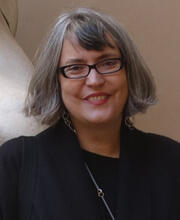 AMY HOLLYWOOD is the Elizabeth H. Monrad Professor of Christian Studies at Harvard Divinity School and a member of the Committee for the Study of Religion at Harvard University. Her most recent book, Acute Melancholia: Mysticism, History, and the Study of Religion was published by Columbia University Press in 2016. Devotion: Three Essays on Religion, Literature, and Politics, co-authored with Constance Furey and Sarah Hammerschlag, is forthcoming from the University of Chicago Press.
AMY HOLLYWOOD is the Elizabeth H. Monrad Professor of Christian Studies at Harvard Divinity School and a member of the Committee for the Study of Religion at Harvard University. Her most recent book, Acute Melancholia: Mysticism, History, and the Study of Religion was published by Columbia University Press in 2016. Devotion: Three Essays on Religion, Literature, and Politics, co-authored with Constance Furey and Sarah Hammerschlag, is forthcoming from the University of Chicago Press.
 GLQ: A Journal of Gay and Lesbian Studies, founded in 1993, offers an exemplary site for understanding the rise of queer theory, which, from the start, has struggled with the tension between institutionalization and radical resistance. By situating the emergence of this journal and queer theory in general within the AIDS crisis and the literary tradition of the elegy, this essay offers a reading of conventional academic practices as rituals of queer melancholia that comes to challenge the assumption of queer theory’s secularity.
GLQ: A Journal of Gay and Lesbian Studies, founded in 1993, offers an exemplary site for understanding the rise of queer theory, which, from the start, has struggled with the tension between institutionalization and radical resistance. By situating the emergence of this journal and queer theory in general within the AIDS crisis and the literary tradition of the elegy, this essay offers a reading of conventional academic practices as rituals of queer melancholia that comes to challenge the assumption of queer theory’s secularity.
The essay begins:
“Time for a new journal,” announce founding editors Carolyn Dinshaw and David M. Halperin in the first issue of GLQ: A Journal of Gay and Lesbian Studies. Time, thus, presents itself as one of queer theory’s central concerns from the start, but what kind of time is ushered in by Dinshaw and Halperin’s words? In their declaration that it is “time for a new journal,” they invoke at least two temporalities. On the one hand, “time,” here, is the historical moment of GLQ’s founding—that opportune moment in the early 1990s when the coincidence of a vibrant and necessary queer politics and increasingly innovative queer scholarship seemed to call for “a journal dedicated solely to this interdisciplinary field, a field that is at once rapidly expanding and delimiting itself.” This time is kairotic time—an opportune moment for decisive action that, in this case, opens up the possibility to reimagine queerness and, what is more, the very queerness of time. On the other hand, the time they invoke is also the regular and regulated time of scholarly production—not only the regularity of a journal that adheres to quarterly publication but also the regularity of newly appearing journals meant to keep apace of the constant development of new fields. Indeed, GLQ’s dominant association with a version of the queer that emphasizes disruption, opposition, and radicality obscures the institutionalized conventions to which it adheres as a journal in the first place.
The extent to which Dinshaw and Halperin acknowledge the significant move toward institutionalization that founding a journal marks cannot be overstated. Instead of forgoing institutionalization altogether, Dinshaw and Halperin “make no bones about the fact that with this journal [they] seek a broader, wider niche for lesbian and gay studies in the academy and in cultural life.” As they elaborate, “Such institutional and cultural acknowledgment brings money, curricular space, and jobs, and such support increases our capacity to do new work.” And even as they recognize that “as everyone is aware, with growing institutional recognition, lesbian and gay studies runs the risk of losing its edge and narrowing its desires,” they do not take this as a reason to disavow entirely the institutional forms that render queer theory legible to the academy. On the contrary, they rely upon institutional conventions just as much as they seek to remake them. As they explain, “GLQ locates itself in this tension, seeks to play it out.” Instead of opposing repetition and disruption, then, Dinshaw and Halperin suggest that the very notion of queer theory that emerges from the pages of GLQ requires the citation of older and established forms. In other words, the radicality of queer theory is inseparable from a logic of iteration, or, as I would suggest, it is precisely through repetition—by which I mean the citation of norms and practices and not the perfectly faithful reproduction of the same old institutional forms—that the very notion of queer disruption is cultivated and even made possible. By attending to the institutional norms from which GLQ draws, we may better situate the journal and queer theory within a set of intersecting conditions including the history of the theory journal, the queer politics of grief in the context of the AIDS crisis, and the elegiac mode of literary studies. The ritualization of these norms, I will suggest, shifts focus away from the queer exceptionalism of iconoclasm, disruption, and shock toward queer repetition, persistence, and survival.
Rather than see the institutionalization and professionalization of queer theory as necessarily restrictive to the field, I turn to the theory journal in order to understand what possibilities for transformation and resistance exist in such a conventional object of the profession. As Jeffrey Williams claims,
The theory journal, in its profusion and institutional mass, did not only report the developments of theory but created the expectation of theory; like a museum that has a wall of frames of a certain size and color to be filled, it precipitated a certain form of writing. Temporally, the theory journal did not merely gather things after the fact but prompted the kind of writing known as theory.
Following Williams, I ask how GLQ, as a theory journal, generates the possibility of new forms of queer theory rather than simply gathers theories that conform with its expectations. Indeed, in recounting the founding of GLQ, Halperin is clear to place it alongside other theory journals like Representations, Screen, Yale Journal of Criticism, Qui Parle, Raritan, diacritics, Textual Practice, differences, and Signs and, therefore, to emphasize the journal’s relationship to literary studies. My focus here will be less on the institutional history of the theory journal and more on the ways in which institutional forms like the academic journal sustain affective attachments and devotions to particular texts, people, and communities.
I will argue through a reading of GLQ that queer theory normalizes intellectual labor as itself a practice of mourning and that this ritualization of grief challenges the assumption of queer theory’s secularity. Following Jacques Derrida, who claims, “All work in general works at mourning,” I suggest that queer theory’s sustained scholarly attention to Freudian melancholia is inextricable from the experience of what I call “queer melancholia,” which forgoes any clear distinction between normal mourning, on the one hand, and pathological melancholia, on the other, in favor of what Jahan Ramazani calls “melancholic mourning,” or a mourning bereft of consolation. By situating the emergence of queer theory amidst the AIDS pandemic and within a longer tradition of the elegy, I hope to show how the practice of queer theorizing is inseparable from the rituals of caring for the dead. Ultimately, to frame queer time within the terms of ritual, I suggest, is both to challenge queer theory’s secularity and the progressive temporality to which it is bound and to arrive at an understanding of how the conventions of ritual repetition in theory can actually give rise to resistance and new forms of communal life. Continue reading free of charge for a limited time …
 KRIS TRUJILLO is Assistant Professor in the Department of Comparative Literature at the University of Chicago, where he teaches and researches Christian mysticism, religion and literature, theories of gender and sexuality, and queer-of-color critique. He is currently working on two book projects. The first examines how rituals of communal, embodied, and affective devotion give rise to Christian mystical poetry. The second offers an intellectual history of ecstasy from early Christianity to queer theory.
KRIS TRUJILLO is Assistant Professor in the Department of Comparative Literature at the University of Chicago, where he teaches and researches Christian mysticism, religion and literature, theories of gender and sexuality, and queer-of-color critique. He is currently working on two book projects. The first examines how rituals of communal, embodied, and affective devotion give rise to Christian mystical poetry. The second offers an intellectual history of ecstasy from early Christianity to queer theory.